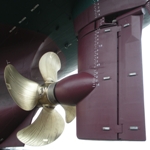Full-Scale Trials Verify Energopac Cost Savings
 In recent trials carried out in co-operation with the Spliethoff Group, the Wärtsilä Energopac solution delivered significant reductions in fuel costs. The trials involved eight 17,700 DWT vessels. The trials have shown that the Energopac solution saves close to 4% power in design condition. This represents annual fuel cost savings of more than USD 120,000 (at fuel prices in July 2010).
In recent trials carried out in co-operation with the Spliethoff Group, the Wärtsilä Energopac solution delivered significant reductions in fuel costs. The trials involved eight 17,700 DWT vessels. The trials have shown that the Energopac solution saves close to 4% power in design condition. This represents annual fuel cost savings of more than USD 120,000 (at fuel prices in July 2010).
Six of the Spleithoff vessels were fitted with standard rudders and two with the Energopac integated rudder and propeller. “After six months of operation, it has been shown that the reality confirms the theory”, said Frank Louwers, director at Spliethoff. “This facilitated our decision to install the Energopac propulsion solution on the next series of another five vessels.”
Launched in 2008, Wärtsilä’s Energopac is an easy-to-install rudder/propeller combination that features a rudder bulb located behind the propeller hub. The bulb is mounted on a custom-designed full-spade flap rudder. As each Energopac installation is designed to fit a specific vessel, it can be fully optimized for energy efficiency without compromising manoeuvrability or comfort levels. Wärtsilä’s in-house computational fluid dynamics (CFD) resources are used in developing an optimal design for the total system.
“Energopac is an effective way of reducing the operational costs of any vessel which spends a significant proportion of time in non-stop sailing,” says Marcel van Haaren, Manager, Sales Engineering, Wärtsilä Ship Power. “Hub losses in a vessel equipped with a conventional rudder/propeller arrangement are significant, but these can be greatly reduced by installing an Energopac system. An increasing number of ship owners are looking to invest in technology that improves energy efficiency and reduces fuel consumption and emissions, and Energopac is a very effective solution.”
For ships with highly-loaded controllable-pitch propeller systems, such as RoRo vessels, ferries, container/multipurpose vessels and vessels with an ice class notation, the potential savings with Energopac are large. Bornholmstrafikken‘s RoRo vessel M/V Hammerodde, for example, reported that results are even better than the predictions obtained from model tests carried out prior to the installation of the Energopac solution.
In addition to the Energopac systems already delivered, another twenty Energopac systems have been ordered and will be delivered in 2010 and 2011. Reductions in fuel consumption depend on the vessel type, its operational profile and also on the reference propeller and rudder. The performance improvements determined through CFD calculations and/or model tests indicate power reduction values ranging from a minimum of 2% per cent to a maximum of 9%.






